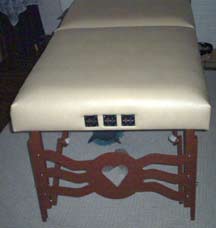|
|
|
Five Pathways to Perceiving Sound
There are five ways pulsations can be perceived in the human body in the auditory frequency range. Each of theses sensory pathways has a different mechanism, but all of them reinforce the sounds that come in through our ears. The general term that has been adopted for these additional four pathways is "Tactile Sound". The range of tactile sound, as identified by Clark Synthesis, is from approximately 1Hz to 800Hz. This is quite a bit higher than what subwoofers deliver, and extends into the lower registers of the human vocal frequency ranges.
In the tables that I build, this technology is utilized with music and frequencies that introduce deep relaxation and vibrations to the body designed to help the client regain balance and health at a cellular level. Whether you incorporate a Tactile Sound Massage Table with regular massage, energy work, to balance the chakras, meditation or to de-stress after a long day, the results and healings that have occurred have been remarkable. For whatever purpose you utilize the table for, the following describes why the results are more effective than on a soundless table.
Five
Pathways to Perceiving Sound
- From Clark Synthesis
1. Hearing Via Air Transmission:
The standard way we perceive acoustic energy is through our ears. The mechanism is simple. Vibrating air molecules enter the ear canal and push against the eardrum. This energy is transmitted to the Cochlea through the inner ear bones. The Cochlea is a fluid-filled sense organ in which small hairs, Cilia, convert mechanical vibration. Sound waves push on the eardrum, which mechanically stimulates the three ear bones. These push on the oval window of the Cochlea and create the sensation of sound.
2. Feeling Via Deep Tissue Movement:
The ground vibrating almost imperceptibly beneath our observers is stimulating nerve endings in deep tissues and muscle mass. This sense is called "kinesthetic". It comes from the Greek word kinos, which means, "to move". These kinesthetic sensations are the gut feelings that occur when powerful objects excite the ground near us.
3. Feeling Via Skeletal Joint Movement:
The ground vibrating beneath our observers is also stimulating nerve endings in skeletal joints and deep tissues. This sense is called "haptic". It comes from the Greek word haptein, which means, "to touch".

4. Feeling Via Tactile Stimulation:
The ground moving beneath our friends is also stimulating nerve endings just under the outer layer of skin. This sense should be familiar to you; it is your sense of touch. Ordinarily, the sense of touch does not come into effect with acoustic events except in situations where excessively loud noises are produced. It also comes into effect for musicians who hold their instruments close to their bodies when playing.
5. Feeling Via Bone Conduction:
The Cochlea, the sense organ that takes the mechanical movements of acoustic energy and translates them into nerve impulses, is firmly encased in the skull bone. This bony protection allows a secondary pathway for sound waves to reach the Cochlea; directly through the bone mass itself. The phenomena of bone conduction is well known and has been exploited by many people. For example, in cases of structural hearing loss where the eardrum or inner ears bones are damaged beyond repair, various companies manufacture bone conducting "hearing aids." These devices clamp onto the back of the ear, or are actually implanted into the skull, to directly stimulate the Cochlea via local bone conduction.

